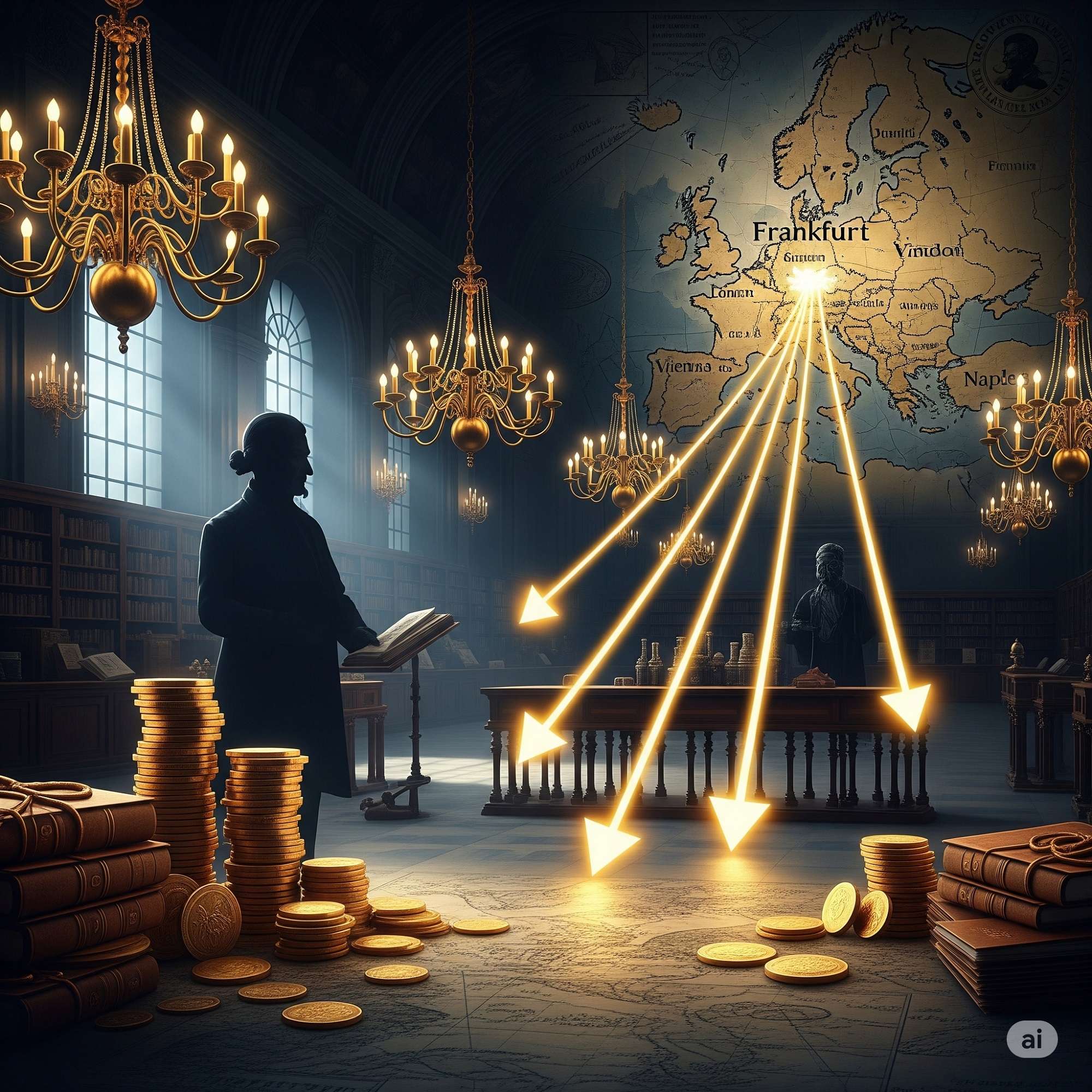- 10 July 2025
- No Comment
- 335
How the Rothschild Family Built the World’s Greatest Secret Fortune

Imagine sitting at your kitchen table and discovering that one family, just a handful of people, held more financial clout than kings, financed wars, built railroads across continents, and controlled markets from the shadows. It sounds like a blockbuster movie premise. But this is the real story of the Rothschilds, a family whose name became shorthand for secret riches and quiet power. Their journey begins in a cramped 18th‑century ghetto and stretches across centuries, weaving through wars, revolutions, scandals, and innovations. Let’s dive into how five brothers turned a small trading shop into the most far‑reaching banking dynasty the world has ever known.
From Ghetto Stalls to a Grand Vision
Life in Frankfurt’s Jewish Quarter
Picture a narrow alley in Frankfurt, Germany, in the mid‑1700s. The street is lined with makeshift stalls selling second‑hand clothes and dusty trinkets. Jews like Mayer Amschel Rothschild lived under strict rules—they couldn’t own land, join most crafts guilds, or take certain jobs. Money was tight, prejudice was constant, and opportunity seemed out of reach.
Yet, young Mayer was restless. He saw limitations not as walls but as puzzle pieces begging to be rearranged. While his neighbors bartered used coats, Mayer dreamed bigger. He wasn’t content just to trade; he wanted to transform how trade worked.
The Rare‑Coin Gambit
One day, Mayer spotted a chance when a wealthy local prince, William of Hesse‑Kassel, hunted rare gold coins. Mayer borrowed funds, snatched up the coins himself, then sold them to the prince at a tidy markup—collecting both his commission and the price difference. Think of it like buying concert tickets the moment they go on sale and flipping them online at double the price—only Mayer was doing it centuries earlier, and on a grander scale.
By the early 1780s, Mayer had not just earned the prince’s trust but had become Frankfurt’s wealthiest man. His secret? Treat money as a tool, not a trophy. He pictured a legacy far beyond his own lifetime—a banking network that would outlive kings.
Building an International Team—Mayer’s Five Arrows
You can’t conquer the world alone. Mayer saw his five sons as his greatest assets. He placed them like arrows ready to fly:
- Amschel stayed in Frankfurt to keep the home base strong.
- Salomon headed to Vienna, the heart of Habsburg power.
- Carl went to Naples, connecting with Mediterranean trade.
- James set up in Paris, rubbing shoulders with revolutionaries and royals alike.
- Nathan, the boldest of all, was sent to London—the rising star of global finance.
By spreading out, the Rothschilds became an early version of a multinational firm: each branch traded information, money, and favors with lightning speed across Europe.
Nathan’s London Leap—Turning Textiles into Gold
The Textile Trio Trick
When Nathan landed in London with a hefty investment from his father, the city was buzzing with textile mills churning out fabrics faster than ever. Rather than simply buy and sell cloth, Nathan cut out the middlemen. He supplied raw materials, handled the dyeing, and sold the finished fabrics—capturing three profits instead of one. It’s like planting a seed, watering it, and then selling both the sapling and the blooms.
In just a few years, his £20,000 turned into £60,000. But Nathan wasn’t done. He secretly smuggled goods around Napoleon’s blockades—think of it as a high‑stakes underground railroad for silk and silver.
Family First—Mayer’s Last Lesson
As Mayer’s health declined, his final charge to his sons wasn’t about interest rates or ledgers—it was about loyalty. “Above all,” he said, “guard our unity.” That simple creed—family above all—became their superpower, letting them weather shocks other banks couldn’t imagine.
Information Is Gold—Winning the Napoleonic Wars
Europe in the early 1800s felt like a giant chessboard. Napoleon’s armies swept across countries, and governments needed cash to pay soldiers and buy supplies. The Rothschilds, with offices in Frankfurt, Paris, Vienna, Naples, and London, were poised to help—but it wasn’t just their reach that mattered. It was their speed.
They built a private courier network—horses, carrier pigeons, even semaphore towers—that outpaced official dispatches. When the Duke of Wellington beat Napoleon at Waterloo, the Rothschilds heard the news days before anyone else. They used this “insider” edge to buy British government bonds at rock‑bottom prices, then sold them at a windfall. In one legendary deal, Nathan bought 800,000 pounds in gold for Britain, organized its secret transport across war‑torn Europe, and made “the best business I ever did” in his own words.
Railways, Revolutions, and Rescue Missions
James and the Iron Horse
Once wars subsided, James in Paris turned his eye to the next big thing: railroads. Tracks were crisscrossing Europe, promising to shrink distances and spark industrial booms. James didn’t just lend money; he formed “syndicates,” pooling investments so massive projects could launch without risking the family’s entire fortune. Soon, Rothschild rails sped trains from Paris to the Pyrenees and beyond.
Family Bailout—Lionel’s Big Gamble
But success breeds envy. Amid the 1848 revolutions in France, angry crowds blamed bankers for economic hardship. The Paris branch nearly collapsed. Without hesitation, Lionel in London wired funds to save his uncle’s bank—even though it risked huge losses. That rescue cemented two truths: Rothschilds always stuck together, and their money had power beyond interest rates.
Lionel also broke barriers in London politics by refusing to pledge on the New Testament alone, insisting on his Jewish faith—a move that helped loosen Britain’s religious restrictions and showed the family’s reach now touched parliaments, not just palaces.
A New Challenger—America’s House of Morgan
As the Rothschilds thrived, a new banking titan rose in America. Junius Morgan built a partnership that caught the French government’s eye during the Franco‑Prussian War of 1870. While the Rothschilds hesitated to fund a likely loser, Morgan bet on France’s ability to repay. His gamble paid off handsomely—and suddenly Morgan and Rothschild were neck and neck on the world stage.
Later, when the U.S. teetered in the Panic of 1893, J.P. Morgan and the Rothschilds teamed up to prop up America’s gold reserves. Their Gold‑backed bonds sold out in minutes, saving the young republic from financial ruin—and cementing an unprecedented transatlantic alliance.
Cracks Appear—World Wars and Internal Strife
Brothers at War
In World War I, the family found itself divided: London and Paris backed the Allies, Vienna backed the Central Powers. Though they profited by funding governments, the war’s carnage and shifting borders weakened their old‑world grip. Meanwhile, J.P. Morgan’s heirs surged ahead financing the victorious Allies, and New York became the new capital of global finance.
Persecution and Escape
With the rise of Hitler in the 1930s, the Rothschilds in Austria and Germany faced Nazi persecution. Their banks were seized, estates confiscated, and family members forced to flee. It was a devastating reversal: the dynasty that once seemed invincible was scattered like leaves in a storm.
Scandal and Reinvention in the Modern Age
In the 1990s, a new drama unfolded. Media baron Robert Maxwell misused pension funds and, upon his mysterious death in 1991, left a trail leading back to banks trying to cover up losses. Though the Rothschilds’ exact involvement remains murky, the association dented their aura of discretion.
Inside the family, a rift grew: Jacob Rothschild pushed for bold expansion, while Sir Evelyn de Rothschild insisted on staying a private, closely held bank. That tension—between growth and tradition—has shaped their path ever since.
Today’s Rothschilds—Quiet Influence, Diverse Ventures
You won’t see Rothschilds plastered on skyscrapers, but their name still opens doors. The modern family is a constellation of branches investing in energy, mining, real estate, and, yes, still advising governments and corporations on finance. But the era of one all‑seeing patriarch has given way to a looser network—private, low‑profile, and spread across the globe.
Why the Rothschild Story Still Matters
- Family Bonds as Business Strategy
Their “five arrows” plan shows how unity can amplify individual talents into a collective powerhouse. - Speed and Information
Before electronic trading, they built a human‑powered internet—couriers and pigeons—to stay ahead. - Risk‑Sharing and Syndicates
Pooling capital early on enabled them to take on colossal projects without jeopardizing everything. - Moral Toughness
They backed each other in crises, refused to abandon branches under fire, and even challenged societal norms, like Lionel demanding religious equality in Parliament. - Adaptation
From coins to textiles to war funding to railroads to modern advisory services—they continually reinvented themselves.
The Shadows They Cast—and the Light Ahead
The Rothschilds’ saga reads like an epic novel, yet it’s real history. They teach us that fortunes are made as much by relationships, speed of information, and family loyalty as by risk and capital. Their story also reminds us that no empire—financial or political—lasts forever. Today’s “masters of the universe” may be tech billionaires or hedge‑fund titans, but the blueprint laid by Mayer Amschel Rothschild remains surprisingly relevant.
So next time you swipe your card or read a headline about high‑stakes finance, remember: behind the scenes, networks of people—connected by trust, shared vision, and sometimes a secret handshake—are weaving the world’s future. The Rothschilds may no longer be the wealthiest, but their legacy of innovation, unity, and discreet influence still shapes how money moves in the shadows.



